Desert Beginning

© 2015 Ali Almimar
Between 2,500 and 4,000 years ago, the Arabian horse was clearly illustrated on the walls of caves that show the small, fine muzzle, pointed ears, deep cheeks, short back, slender limbs and dished facial profile which remain some of the most distinctive features of the Arabian horse. While its origin is lost in antiquity, many scholars and breeders agree that the Arabian horse is the same as its ancestors from thousands of years ago.
Somewhere in the inhospitable deserts of the Middle East, centuries ago, a breed of horse came into being that would influence the equine world beyond all imagination. In the sweet grass oasis along the Euphrates and Tigris Rivers in the countries that are now known as Syria, Iraq, and Iran, and in other parts of the Arabia peninsula, this hearty horse developed and would soon be known as the “ARABIAN HORSE”.
Evidence of the domestication of horses emerged in Syria, dating 2000 BC. In an excavation, halters adorned the bones of horses and horses in artistic drawings. In 1330 AD, the first pedigrees recorded referred to the Arabian by name, although there was no mention of strains or types. As time went on, early travelers questioned the crossing of apparently different “breeds” by the people of the Desert. These were not, in fact, different breeds but strains, or families, of the same breed.

The origin of the name “Arab” is unclear; possibly derived from the concept of nomadism “Arabha,” Hebrew for a dark or steppe land, or “Erebh,” opposed to the ordered life of stationary communities. “Arab is a Semitic word meaning ‘desert’ or the inhabitant thereof, with no reference to nationality…the Arabian became known as the hot-blooded horse of the ‘Arabas’.” Though the origin of the Arabian horse remains a mystery, his lineage traces back five thousand years.
The first and most famous Arabian horse breeders were Bedouins, nomadic tribesmen that roamed the vast deserts of the Middle East.
Breeding good horses was crucial to their survival and prosperity. Only the finest specimens could reproduce. Breeders concentrated on performance, selectively breeding certain bloodlines for stamina, soundness, speed, disposition, and loyalty. They kept strict oral histories of pedigrees that were passed down from one generation to the next.

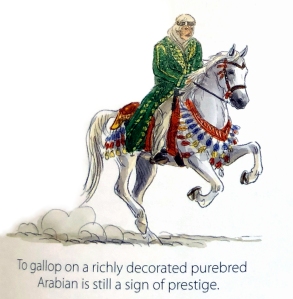
Bedouins prized mares above all possessions. Females didn’t nicker when approaching enemy tribes. They carried their masters into battle with courage and pride, standing loyally by the fallen, leaving only when forcibly led away. No greater gift could be given than an Arabian mare, and the value placed upon the mare led inevitably to the tracing of any family of the Arabian horse through the dam or female parent.

The only requirement of the sire was that he be “Asil”. If his dam was a “celebrated” mare of a great mare family, so much the better.
Mare families, or strains, were often named according to the Sheik or tribe that bred them, and some Sheiks still maintain a herd of milking camels for their mares, feeding them fresh camel’s milk and dates at sunset.
As Islam spread, Arabians were used in the fulfillment of the jihad (the struggle against enemies of Islam), and these horses were woven into the fabric of the culture.
The purebred Arabian was prized –regarded as a gift from Allah.

Basic among many variations are the Muniqi, Saglawi, Abayyan and Kuhaylan, all descending from the Kuhaylan, which means “purebred.” Each strain showed distinctive characteristics, no doubt as the result of the individual needs or type preference of the tribe members. Today’s Arabian is a product of constant crossing of these strains, as no individual carries the blood of a single, undiluted strain. This is not to say that an Arabian of pure, undiluted, desert blood does not exist. Therein lies one of the major differences in the Straight Egyptian Arabian and those of other bloodlines.
Twenty strains are known today and only twelve are considered having kept pure.
The other eight are known to have been crossed with Turcoman stallions.

The Pyramid Society shows 11 strains in their Manual of Straight Egyptian Arabian Horses:
Kuhaylan (Kehilan)
Abbeyyan (Abeyan)
Dahman
Hadban
Saqlawi (Seglawi)
Rabdan
Muniqui
Shuweyman
Wadnan
Samhan
Hamdani
The tradition says that on one occasion Muhammad, the prophet of Allah the Merciful, established his camp on the banks of a river of silvery reflections and crystalline waters, and with him were a hundred mares … “Then by inspiration of Allah Muhammad he decided not to give water to drink the mares for three days and three nights, which made the animals suffer cruelly. On the fourth day Muhammad ordered the mares to be released and these, of course, make them rush to the river to quench their thirst … At that moment the prophet ordered his trumpets to touch the load, and from the herd that galloped to the river five dry mares were separated, those which returned to their master prior to drink water. Madeah then gave them his blessing and decided that only they were dedicated to the breeding … “Those five mares were known from that day as Khamsa al-Rasul Allab. That is, “The five of the prophet of Allah” and were baptized individually with the names of: Abbayab, Saqlawiyab, Kohailan, Handaniyab and Habdab …


The horses found among the nomadic Bedouin possessed certain common physical traits regardless of their particular strain or family. Those who survived to maturity all had the unmistakable look of an enduring athlete and warrior. In the physical sense, “Desert Type” can best be described by the following general traits:
- Heads have more distance from the eye to the top of the skull than from eye to eye across the face.
- The top of the skull is in line with the eye and nostril, not bending backwards above the eyes.
- The bones of the lower jaw taper from jowl to incisor.
- Eyes that fill their sockets.
- Unobstructed breathing represented by a well-defined trachea/esophagus leading to widely spaced jowls.
- A definite break in the outline between the neck and withers.
- Withers slightly higher than croup.
- Relatively short, strong backs.
- The base of the dock of the tail is set from the point of the buttocks.
- The deepest point of the body is between the forelegs.
- A noticeable girth groove.
- The ratio of trunk and foundation strength to height at the withers is a lower number in Desert Breeds than in other Arabians.
- Exceptionally well-shaped hooves and sound legs.
- Thin skin and a noticeable bloom to the coat.
- An overall appearance of a finely tuned athlete.

Strains of Desert Bred Arabians
Strains or families are frequently used terms for grouping certain horses according to their various Bedouin breeders. In the desert when individual horses distinguished themselves in battle or performed exceptional feats of speed, courage or endurance, strains or families were developed from them. Certain tribes would focus on their influence, line breeding and inbreeding to them producing special characteristics unique to their family which was given a strain name, such as Kuhaylan, Abayyan, Hamdani, Dahman, Hadban, Saqlawi & Muniqi. The strain name was handed down from the tail female line according to Bedouin custom as they rode only mares in warfare. Great sires were prized for the strain or tail female line that they represented. Although strain names are passed on through the tail female line, care must be given to place certain emphasis on the entire pedigree (all the strains represented) as well as that of the tail female line in order to correctly perceive an individual or plan a breeding.
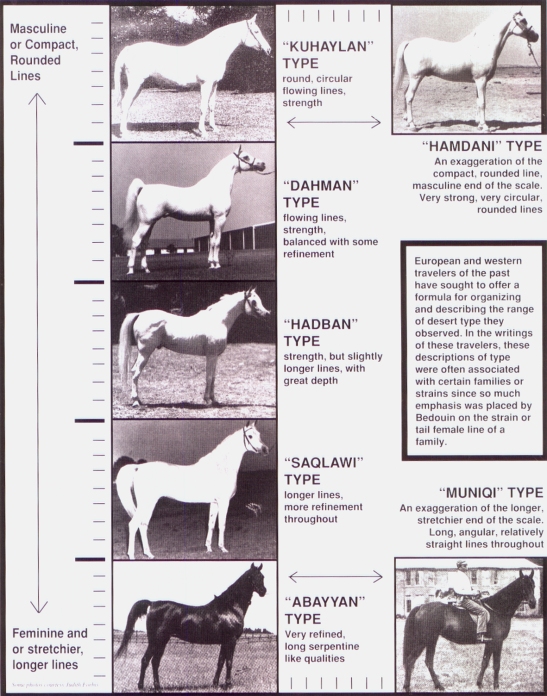
Kuhaylan
In general the Kuhaylan strain is characterized by a more masculine, balanced and symmetrical appearance. They are broad across the chest, back, croup, forearm, and gaskin. The forehead is usually flat, if any bulge (jibah) appears it is usually above the eyes. The head is usually wide and short with small, alert ears. The Kuhaylan tend to be of a quieter nature. They have a more forward type of movement which creates a look of flowing lines from head to tail. While the Kuhaylan Ajuz and Kuhaylan Haifi are very similar, the more rare Kuhaylan Krush tend to have a more sinuous appearance.
According to Carl Raswan: Kuhaylan = Strenght, deep and wide chest and hindquarters (as opposed to the feminine beauty of the Saqlawi). Rounded lines (as opposed to angular Muniqui). Ideal saddle horse with tremendous endurance and height around 14 to 15 hh.
The Kuhaylan strain is represented by three branches: The Kuhaylan Ajuz descending from the Sa’ud mare, *Turfa; the Kuhaylan Haifi descending from the Davenport mare, *Reshan, and the Kuhaylan Krush descending from the Davenport mare, *Werdi.


KUHAYLAN
The Legend of the Kuhaylan Strain
- Raswan Index and Handbook for Arabian Breeders, preserved the story of how the first Arabian horse appeared among the Bedouin Arabians. The Angel Gabriel (JIBRAIL in Arabic) descended from Heaven to Earth while Ishmael was sleeping. Suddenly Ishmael awoke when a “wind-spout” whirled toward him and scorched the sand with its feet. Gabriel commanded the thundercloud to stop scattering dust and rain. The rain that gathered developed into a prancing, handsome creature that seemed to swallow up the ground. Hence, the Bedouins bestowed the name “Drinker of the Wind” to the first Arabian horse, whose name was KUHAYLAH.
Hamdani
The Hamdani are considered historically as being Kuhaylan related. Like the Kuhaylan they are more masculine but of a slightly longer frame with a very strong back and more prominent withers coming well out of the back. They are slightly taller having strong bone of quality and substance with large joints. The head of the Hamdani is clean and wedge-shaped without a lot of detail or prominence of tear bone and is slightly longer than the Kuhaylan. The hind quarter is somewhat egg-shaped creating the picture of power and speed.
According to Carl Raswan: Hamdani = Hunter type; large head with straight profile, broad between the eyes and less dry. Croup not straight and height around 14.2 to 15.2 hh.
The Hamdani are considered the best in endurance and stamina yet with very quiet dispositions. They are most often bay or grey with very little white.


HAMDANI
Abbeyan
Abbeyan are listed as the 6th chapter in the Abbas Pasha manuscript. Originally a substrain of Saqlawi. Ideally is very similar in type to the Saqlawi. Name originated when during a raid a bedouin threw off his ‘beyyah’ (cloak) to lighten his mare’s burden, and when he finally had out distanced his pursuers, he looked back and found his Abeyyah had been carried on the high-borne tail of the mare. Thereafter, the strain was named Abeyyah – for the mare who carried the abeyyah on her tail. Very showy like Saqlawi, somewhat longer back. Elegance personified. Extreme tail carriage.
The Abayyan are more refined than the Kuhaylan and Hamdani and slightly smaller. They are noted for extreme tall carriage and a more lofty type of movement. The head is characterized by a bulging Jibah at the forehead and a fine, tapered muzzle. The Abayyan are longer in the back with a slight saddle-back appearance and high set of the tall. They are very deep in the barrel and forehand with broad forearms and a serpentine like appearance. The shoulders are very prominent with long withers and very clean boned straight legs. The Abayyan are more spirited than the Kuhaylan and Hamdani. They are usually bay, grey or chestnut with white markings more common than in the Hamdani
Head: Resembles Saqlawi, but somewhat longer skull with elongated, convex, bulging forehead.
Fine muzzle and delicate nostrils.
Huge eyes, dark, set deep. Strong jowls.
Neck: Refined and well-shaped. Relatively long.
General Conformation: A Usually deep chest. Extremely long forearm. Very Straight hind legs (indicating great speed in spite of the small size of the Abeyyan, which Raswan commented were rarely over 14 hands if pure in the strain). Today’s horses of this strain are taller.
High tail carriage. Somewhat “saddle” or soft back.
Withers extend further into the back than most other strains.
Proportionally immense shoulders. Favored for polo horses because of sure firmness and agility.
Long fetlocks were typical of this family strain.
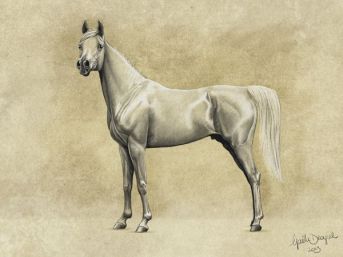
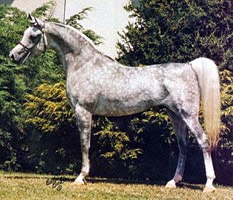
ABBEYAN
Dahman
Dahman are reputed to be from the horses of King Solomon. The name “dahman” means the “dark or black.” Originally it was a substrain of the Saqlawi and represents an ideal blending of the Kuhaylan and Saqlawi type. The Dahman crosses exceptionally well with the modern Saqlawi strain. Most distinguishing characteristics: balance and harmony.
The Dahman are very classic in type and this strain resembles somewhat the Abayyan and Saqlawi (related) strains in elegance but with more of the strength of the Kuhaylan. It is an intermediate blend of the Kuhaylan with the Saqlawi-Abayyan type. The head is short and broad like the Kuhaylan but with more bulge and jibah.
They are compact with lines more like the Kuhaylan but with more over all refinement. They are of medium build, usually with dry flat bone.
The Dahman strain is presently represented by only one female line, that of *Sawannah imported from Bahrain in 1954. The line is carried on through her daughter, *Hadriya by the previously mentioned, *Jalam Al Ubayan. This line descends from a Dahmah mare of Sheikh Sulman bin Hamid al Khalifa, ruler of Bahrain.
Head: Delicately shaped (refined), exceptional beauty, broad and relatively short head with balanced proportions between eyes and poll, and eyes and nostrils.
The head is concave in profile, frequently with a pronounced “dish”.
Eyes are large and very expressive.
Ears are small and thorn-like.
Neck: Harmoniously balanced with the body.
Throats are well-shaped and clean. Good poll setting.
General Confirmation: Strong top lines, relatively short backs in comparison to Saqlawi and Hadban.
Level groups of good length, good hips.
Legs are clean and fine-boned.”
Height: 14.2 to 15 hh


DAHMAN
Saqlawi
Are listed as the third preference among all the strains documented in the Abbas Pasha manuscript. The name apparently derives from saqla – meaning a kick. It is said there was an old Kuhayla Ajuz mare among the Kamsa and she was “a saqla mare,” meaning while galloping she kicked her heels in the air. And so the strain was named after her, Saqlawiya.
Most distinguishing characteristics: Feminine grace and elegance. The ideal Saqlawi represents beauty and refinement in the extreme. Feminine in appearance, they are of equal endurance to the Kuhaylan strains. Lighter and leaner in frame that the Kuhaylan, they are not as strong in the hindquarters, tending to be a bit “light behind,” with a tendency to stand under slightly.
They are very high-spirited and are natural show horses. They have also succeeded admirably on the race track. The tendency to white markings (blazes, stockings, etc.) comes up through the Saqlawi lines.
Raswan noted a preponderance of chestnuts with flaxen manes among this strain; more grays in the Kuhaylan. This is also true among the Moniet´s family today.
Head: Longer and slightly narrower than the Kuhaylan.
Longer foreface (eye to muzzle), somewhat resembling the beautiful desert racing camel’s head in proportion.
Very fine muzzle (the teacup muzzle).
Eyes are large, dark and placed lower in the skull than in the Kuhaylan.
Nostrils are extremely fine.
Skin and hair very silky.
Neck: Longer than the Kuhaylan, but in proportion to a longer body.
Well-shaped and slender, and carried high.


SAQLAWI
Hadban
The Hadban is a strain about which there is little descriptive information. It is considered to be comprised of influences from both the Saqlawi and Kuhaylan strains though not actually a blend of both.
The general appearance of this type is one reflecting the strength of the Kuhaylan but with more scope in flowing lines. Of strong build with great depth of heart and very large shoulders, substantial bone but also showing some refinement created by the effect of longer lines and great style in movement.
The head is large and broad with bony details, relatively straight profile and large eyes. They are considered to be of great endurance and easy keepers. Bay or brown was the predominant colors.
In Sheykh Obeyd bloodlines tail-female Hadban families include, the strain Hadban-Inzihi root mare Venus, D.B. ca. 1890.


HADBAN
Arabian Horses Spread to Europe
European horses soon felt an extensive infusion of Arabian blood, especially as a result of the Christian Crusaders returning from the East between the years 1099 A.D. and 1249 A.D. With the invention of firearms, the heavily armored knight lost his importance and during the 16th century handy, light and speedy horses were in demand for use as cavalry mounts. Subsequent wars proved the superiority of the Arabian horse as the outstanding military mount throughout the world.

© 2015 Ali Almimar
After the Crusades, people of the Western world began looking at the people of the East for Arabian bloodstock. Between 1683 and 1730 a revolution in horse breeding occurred when three Arabian stallions were imported to England. The Darley Arabian, the Byerley Turk and the Godolphin Arabian founded the Thoroughbred breed. Today the majority of all modern Thoroughbreds can be trace to these three Arabian sires.
In the 1800´s travelers in the Victorian era became enamored with the horse of the desert as significant Arabian stud farms were founded throughout Europe. The royal families of Poland established notable studs, as did the kings of Germany and other European nations. As a result of Lady Anne Blunt and Wilfred Blunt’s historical sojourns into the desert to obtain Egyptian and desert stock, the world-famous Crabbet Arabian Stud was founded in England. This stud eventually provided foundation horses for many countries, including Russia, Poland, Australia, North and South America and Egypt.

Careful Breeding
The Bedouins paid careful attention to breeding only the best to the best, keeping pedigrees pure and not diluting the genetics of their precious blood lines. This concentration of genetics makes Arabian DNA prepotent or dominant in passing on the trademark characteristics of refinement, stamina, soundness, and intelligence.
The tradition of improving a breed through the infusion of Arabian blood still thrives. In fact, the use of Arabian blood to strengthen other bloodlines has occurred so often throughout history that most modern recreational or “light” breeds such as the Quarter Horse, American Saddle-bred and Morgan have been crossed, at some point, with the Arabian horse. The purebred Arabian was the original racehorse, bred to withstand the toughest desert conditions. Its durability and heart were legendary, and the horse’s reputation spread.

In the 1700’s, three Arabian stallions were imported to England and bred with Barb or Royal mares imported by Charles II.
The resultant offspring became the foundation stock for the Thoroughbred breed. Over 98 percent of all modern Thoroughbred pedigrees trace back to two of these stallions. The intermingling of Arabian blood with the Thoroughbred breed was so pervasive, that the American Jockey Club continued to accept purebred Arabian horses in its studbook until 1943.
Today Arabians race around the world, competing for more than $5 million in purses every year in the United States alone.
The Byerley Turk (1680-1696)

Captain Robert Byerley captured a black horse from the Turks at the siege of Buda in Hungary in 1686. The Byerley Turk, as the horse came to be known, was the first of the three foundation stallions to come to Britain. He was brought to England in 1689. The Byerley Turk founded a line of Thoroughbreds with the foals from the small number of mares he was bred to. His most important descendant was Herod, foaled in 1758, whose success as a sire assured the continuity of the Byerley line.
The Darley Arabian (1700-1733)

The second of the three Arabian foundation stallions to be imported to England was foaled in 1700 and bought by Thomas Darley in Aleppo, Syria in 1704 for his brother Richard. Once at the Darley estate, Aldby, in Yorkshire, the stallion was bred to numerous mares. Two very important colts are Flying Childers and Bartlet’s Childers, that came from these matings. Through the Childers line, the Darley Arabian was the great-great-grand sire of Eclipse.
The Godolphin Arabian (1724-1753)

The third and final foundation stallion to come to England was imported from France in 1729 by Mr.Edward Coke. The stallion was a gift from the Bey of Tunis to Louis XV of France who reportedly put him to work, drawing a cart through the streets of Paris. An Englishman named Edward Coke then bought and shipped him back to England. After Coke’s death the horse was bequeathed to Roger Williams, who in turn sold him on to the second Earl of Godolphin. The Earl put him to stud at Babraham in Cambridgeshire where he became the most prized stallion, siring around 80 foals. Although the Godolphin Arabian never raced himself, there was no shortage of winners among his foals. Mating with the distinguished mare Roxana produced Lath, he won the Queen’s Plate at Newmarket racecourse in nine out of nine races. He was the greatest racehorse in England after Flying Childers, and Cade, the sire of the great Matchem. Lord Chedworth’s Regulus was another important offspring. “The blood of the Godolphin Arabian is in every stable in England.” was a true statement by 1850.
Unique Blood lines
Unlike many breeds that originated in the United States, the Arabian horse is centuries old, its presence worldwide. From the late 1800’s through the 1930’s, breeders spanning the globe imported stallions and mares from Middle Eastern countries to develop strong national Arabian horse breeding programs. Consequently, Arabian blood lines are sometimes further delineated by the country of importation.

Crabbet Bloodline:
“Crabbet horses” are from the Crabbet Stud, an English estate owned by Lady Anne Blunt who imported foundation stock from Egypt in the 1800’s. Her horses have influenced breeding programs in Australia, Holland, Spain, Poland, Russia and the United States. Among the horses the Blunts acquired on these journeys were the bay filly Dajania, purchased 1877; a dark bay mare eventually named Queen of Sheba, purchased from the Sheykh of Gomussa and his cousin in the summer of 1878; and a chestnut mare named Rodania.

All three have left many descendants. Through their connections among the tribes, the Blunts also heard of a celebrated grey stallion. They sent a trusted friend, Zeyd Saad El Muteyri, to buy him; the horse was named Azrek, and became an influential sire.
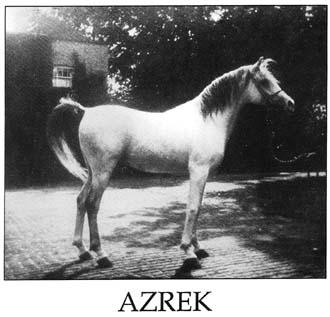
The Blunts made their initial visit in Egypt to Ali Pasha Sherif in 1880 and purchased the stallion Mesaoud

Mesaoud
Lady Wentworth (daughter of Lady Anne Blunt) added the chestnut stallion Dargee, and her most famous purchase, the gray stallion Skowronek

Skowronek
Horses with *Raffles, *Serafix and *Skowronek in their pedigrees trace back to the Crabbet Stud.


Serafix
The Crabbet Organisation has defined horses from the Crabbet Stud legacy.
Crabbet Stud Bloodlines
A Crabbet Stud bloodline is one from a Pure Bred Arabian that was owned or bred by the Crabbet Stud, including those registered as bred by the owners Lady Anne or Wilfrid Blunt, Lady Wentworth or Cecil Covey.
Crabbet Arabians
Pure Bred Arabians with 75% or over Crabbet Stud bloodlines.
Old English Arabians
A pedigree group of Pure Bred Arabians with 100% Pre-World War II UK bloodlines, (usually over 85% Crabbet Stud Bloodlines).
GSB Bloodlines
A pedigree group of Pure Bred Arabians with 100% bloodlines imported to the UK by 1920 (registered in the General Stud Book), usually over 95% Crabbet Stud bloodlines.
Straight Crabbet Arabians
A pedigree group of Pure Bred Arabians with 100% Crabbet bloodlines.
Crabbet Stud obsessed with creating a lineage of “super horses”, these Arabians were bred for size, resulting in the “tallest horses” of all the Arabians.
Their breeding also prioritized soundness and a sturdy confirmation over looks, and so they can lack some of the more exaggerated elegant features that are today considered hallmarks of the Arabian breed.
This focus, though, makes them excellent riding horses and very well suited for long distances, as they are not prone to foundering or breakdowns of any kind. Because of this lack of preference for aesthetics, Crabbet Arabians can boast any number of solid coat coloring.
Today, most Arabian bloodlines can be traced to having some Crabbet sire influence. A natural athlete, the Crabbet Arabian is sound, a good mover, athletic and possessing a solid temperament, making them highly sought after for under saddle competition.
The endurance riding field, already heavily dominated by Arabian, is particularly suited to the Crabbet Arabians, as well as dressage and show jumping.
Polish Bloodline:
In the early 1800s various Polish Princes and Counts traveled to Arabia in search of Arabian horses ushering in the beginning of modern Arabian breeding in Poland. Early noble studs of Arabian horses in Poland included those established by the Szanguszko Princes, as well as Count Potocki, Count Branicki and Count Rzewuski. The desert importations were not only bred together but the stallions were also used to upgrade native stock. Some Polish importations were also provided for the Weil stud in Germany. Likewise, the very old Hungarian Arabian horse-breeding program provided some of their original Arabian bred stock to Poland. In addition, France became a source of Arabians used in Poland so that Polish pedigrees often represent a blend of several other European sources of Arabians. In this process of exchange, some bloodlines of Polish Arabians also became a part of Russian Arabian horse breeding.
Then, by World War I, the population had been devastated to less than 25 horses.
From there, in the 1920s, the Arabian Horse Breeding Society was formed in Poland and a breeding program begun in earnest.
The success of the famed Polish studs became universally admired after WWII to the point that of the 20 most prolific Arabian sires worldwide today, 16 carry Polish bred ancestors.
Polish stud farms tested their stock on the racetrack before allowing a horse a place in the stallion or broodmare barn. Poland produced Skowronek and exported him at 4 years old to the Crabbet Stud where he became an important breeding stallion. Poland has exported Arabians to the United States since the end of World War I, but the biggest influx came in the 1960’s as breeders brought in greater numbers to develop their herds. *Bask was one of the most remarkable sires to come to the United States from Poland, winning national championships in stallion halter and park and siring numerous horses with his great beauty and ability.

Bask
Arax was the most significant Polish Arabian Horse, imported to Russia in 1958, he was the leading sire at Tersk for ten years.

Arax
*Tamerlan set records at Russian race tracks that have never been broken.

Tamerlan
Based on broodmares, each horse has a lineage that can be traced back at least 100 years in Poland. There are also two general types of Polish Arabians:
The Seglawi, known for their refined looks and exceptional beauty, and the Kuhaylan, praised for their natural athletic ability and more athletic builds.
The Seglawi are most often that Arabian-recognized light gray, while the tougher Kuhaylans are most times born with bay coats.
Physical traits that both types of Polish Arabians share in rarely vary.
In terms of size, these horses are small and very muscular with long withers.
Their tail follows the Arabian tradition of being held high, and so, too, does the neck match: long, graceful and arched.
A lot of the Arabians in the United States are of the Seglawi breed of Polish Arabians.
Poland has three state Studs: Janów Podlaski, Michałów and Białka as well as private Studs, and “proudly serves as the wellspring for the greatest Arabian horses in the world,” according to Horsefly Film’s trailer for their new documentary film, “Path to Glory”: The Rise and Rise of the Polish Arabian horse.”
Most recent important Polish Arabian Stallions are: Pepton, Ecaho & Piaff
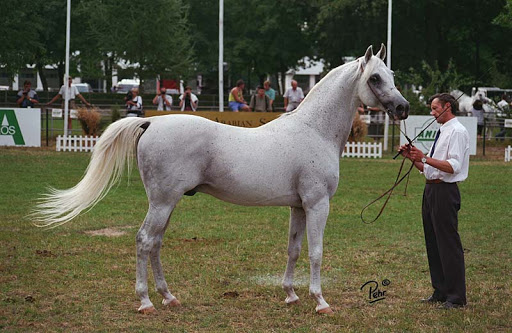
Pepton ( Bandos & Pemba )

Ecaho (Pepton & Etruria )

Piaff ( Eldon & Pipi )
Straight Egyptian Bloodline:
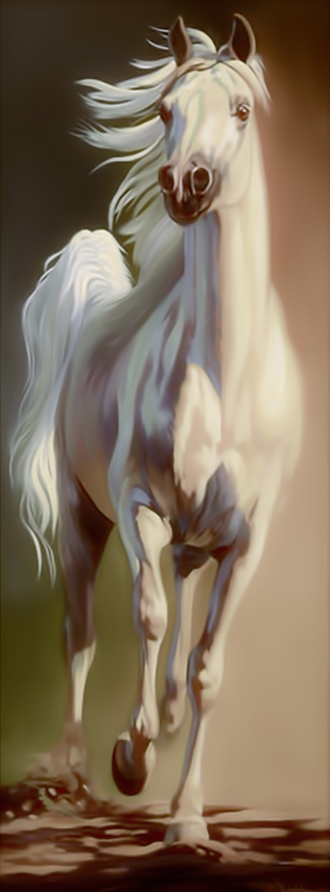
The origin of the Arabian horse in the desert remains a matter of study and controversy. Contemporary Arabian horses descend from stock bred by nomadic Bedouin tribes in Arabia Deserts, an area covering most of what is now Syria, Jordan, Iraq, Saudi Arabia, The United Arab Emirates, Qatar, Bahrain, Kuwait, Yemen, and Oman. These are called the “Countries of Origin.”
The Arab countries of Egypt, Libya, Tunisia, Algeria, Morocco, Sudan, Mauritania, Lebanon, Palestine and Israel, are not homelands of the “Asil horse”. These countries acquired Asil horses through purchase, war or trade, just as did Europe, UK, USA and other Western countries.
Not all Bedouin tribes bred horses. Western travelers consistently reported that the Bedouin tribes with horses were fanatical in their commitment to breeding from Asil horses – those that met the tribal criteria of purity and authenticity. What was Asil for one tribe was not necessarily Asil for another, depending partly on what was known about the horse and its breeders.
The term “Asil” Arabian is today no longer identical with the terms “pure-bred” Arabian, and Arabian horse, because internationally the original definition of purity – a pure-bred Arabian is a horse that must trace all of its ancestors to the Bedouin breeding of the Arabian peninsula – cannot be maintained due to the crossbreeding with other breeds. In order to characterize the Asil Arabians (less than 2 % of all horses accepted internationally as pure-bred Arabians) and to safeguard them in the interests of their preservation, we now use the term “Asil Arabian”.

STRAIGHT EGYPTIAN
The Egyptian Arabian is a lineage of unbroken Pureblood status. Much like registered and recognized Egyptian Arabians can trace their bloodlines all the way back to the herds of horses once owned by Viceroy Mohammed Ali – and his grandson Abbas Pasha I – in Egypt itself.
Since the years have introduced wider gene pools, Arabians have been breed interchangeably so that most bloodlines are mixed. That is where the Straight Egyptian Arabian differs – it is of pure, unmixed desert heritage. In fact, it is the only type of Arabian to be so.

Mohammed Ali the Great, founder of modern Egypt in the 1800’s, established one of the world’s greatest Arabian stud farms with horses imported from Arabia. His descendant Abbas Pasha, the Viceroy of Egypt, built up a herd of more than 1,000 purebred Arabian horses. To qualify as a straight Egyptian horse today requires tracing lineage back to the Arabian desert or to the horses of Abbas Pasha. Until the early 1900’s, breeding was the domain of the royal family. However, the Egyptian Agricultural Organization now oversees the breeding, importation and exportation of horses. The Pyramid Society in the United States, founded in 1970, pursues the preservation of this valuable pool of genetic bloodstock.
Egyptian Arabians can come in a variety of solid colors, and they are also able to be found with rabicano roan coats.
The Egyptian Arabian is smaller of stature, generally falling within the range of 14.2 to 15.2 hands, and possess what many consider to be the most beautiful features, ads part of their selective breeding was for looks.
Elegant bones, a very dished face, and a tail carried extra high set apart this type of Arabian, which makes up only around 2% of the breed as a whole.
Marbach Bloodline:
The Marbach Stud, also known as Weil-Marbach, is Germany’s oldest state stud farm for horse breeding, has a history that dates back over 500 years. It is located in southwest Germany near Gomadingen in the Reutlingen. In 1955, the Arabian stallion Hadban Enzahi was imported from Egypt, along with some other breeding stock, and this infusion of new blood added to the foundation animals established the Weil-Marbach line of Arabians. Since the importation of Hadban Enzahi, the focus of Marbach shifted to Arabian breeding of strongly Egyptian blood lines, though the older lines are also preserved.

Gharib was known as the black pearl of Marbach. After a long period of grey Nazeer sons (Ghazal, Hadban Enzahi and Kaisoon) Marbach imported this Nazeer-free, black stallion from Egypt. Gharib was not only used at Marbach but had also influence on private breeding programs such as the one of Erich Hagenlocher. When during the 1960s, Friesian horses disappeared from international driving and dressage arenas, some breeders decided to return to the roots. These experts began to search for the best desert Arabian blood, which had already been introduced into the breed 400 years ago, to use on carefully selected Friesian mares. They chose the well-known elite stallion Gharib, a straight Egyptian stallion at Marbach State Stud, in order to improve the following characteristics: endurance, toughness, lung and heart volume.
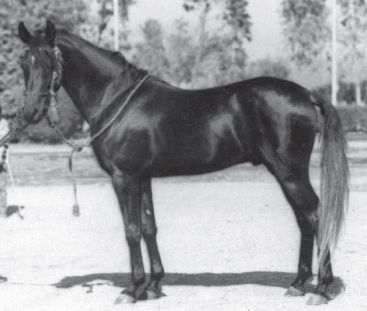
Gharib
Samanna GRSB claim to fame is that she is the dam of *Sharem El Sheikh. Samanna GRSB was bred at the German State Stud Marbach. She is a full-sister in blood to the Aristocrat 17 Champion producing mare *Sanacht.
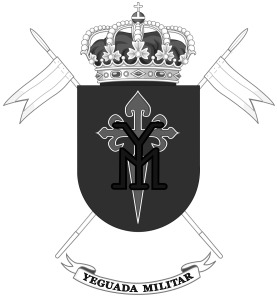
Spanish Bloodline:
During the mid-1800s, the need for Arabian blood to improve the breeding stock for light cavalry horses in Europe resulted in more excursions to the Middle East. Queen Isabel II of Spain sent representatives of the crown to the desert to purchase Arabian horses and by 1847 had established a stud book. Her successor, King Alfonso XII imported additional bloodstock from other European nations. By 1893, the state military stud farm, Yeguada Militar was established in Cordoba, Spain for breeding both Arabian and Iberian horses. The military remained heavily involved in the importation and breeding of Arabians in Spain well into the early 20th century, and the Yeguada Militar is still in existence today.
Even rare than the Egyptian Arabian, though, the Spanish Arabian has a population so small, it is less than .1% of the Arabian breed makeup!
Spanish horses are less diverse in color than their pure-blood Egyptian cousins, and are primarily found in the colors of white and gray
They were bred to be a smooth ride, meaning they are ideal not only for fast runs but especially for longer endurance rides. In fact, the warriors of the Iberian Peninsula needed a horse that was willing to listen while also being very agile and suited to raid warfare.
Thus, the Spanish Arabian was born. Their disposition is calmer than that of the higher strung Egyptian Arabian and, though their faces are both dishy, the Spanish Arabian has a tail that is more curved than straight and high.
Though more genetically diverse than the Straight Egyptian, the Spanish Arabian still has a rather limited gene pool, with no outside blood being introduced in the past 100 years. Because of this, their numbers are smaller.
Spain’s government-owned horses and purebred Arabians imported from Poland, Middle East, England, France and Argentina, formed the basis for the Spanish Arabian. The military used their mare band primarily to produce top stallions, leaving private breeders the task of producing good mares. The small number of horses in Spain and stringent culling left the Spanish Arabian with a concentrated gene pool that’s exceptionally prepotent when out crossed.
Estopa was discovered at the age of five in Spain at the farm of Don Miguel Osuna Escalera, the sagacious breeder who bought her dam, Uyaima, from Yeguada Militar in foal to Tabal. Om El Arab in Germany’s Black Forest, Estopa was mated to the farm’s other famous import – the Morafic son Shaker El Masri from Egypt. This concept of crossing Spanish Arabians with Straight Egyptians was a novel approach to breeding. Despite widespread skepticism in Europe, the subsequent success of the Estopa – Shaker El Masri progeny earned this breeding approach the much celebrated nickname of the “Golden Cross”. On a trip to Egypt with the goal of adding some straight-Egyptian blood to the new herd. They purchased the *Morafic son, Shaker, and five mares. When Shaker arrived in Germany was renamed “Shaker El Masri”, which translates from Arabic to mean “Thankful to Egypt”. The first foal of Estopa & Shaker El Masri was named Estasha. In August 1975 *Estopa delivered her first colt named *El Shaklan, taking the “E” from * Estopa and the “Shak” from Shaker El Masri.

Estopa
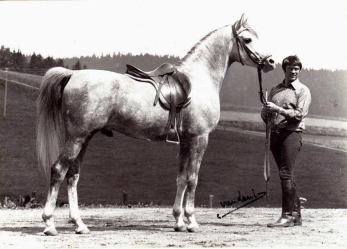
El Shaklan
*Estopa’s best friend was *Mohena. In the spring of 1971 brought seven mares to Marbach State Stud to be bred to the Nazeer son, Hadban Enzahi. The very first foal Om El Arab produced was a very pretty filly we named *Mohena, out of Morisca V, by Hadban. *Estopa and *Mohena were stabled next to one another. *Mohena was the dam of *Sanadik El Shaklan.
Mohena
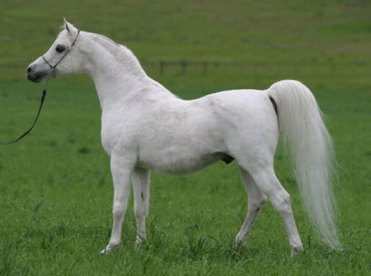
Sanadik El Shaklan
One of the sons of Sanadik El Shaklan was Om El Shareikh sire of MFA Sringtyme dam of Samah
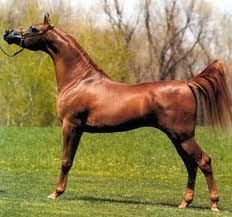
Om El Shareikh

MFA Springtyme

Russian Bloodline:
In 1889 – Count Sergei Stroganov founds his horse stud at the foot of Mt. Zmeika.
2 stallions and 9 mares Stroganov acquired during a trip to Syria and the north Arabian desert in 1888 are to serve as the initial stock for breeding.
1891 – Sheikh Nasra ibn Abdulla donates 2 stallions to Stroganov’s Stud.
1895 – Count Stroganov revisits the middle-east and buys 3 more mares in Damascus
1899 – The Stud has 9 breed stallions and 21 broodmares in stock. The stud’s total stock is 66 purebreed Arab horses, counting yearlings.
On February 11, 1921 – A decree to found Tersk military horse stud is signed. The farm is to provide cavalry officers with Arab horses. The farm is named after the Tersk Cossack force located nearby. As the entire stock of the stud has been lost in the war, the stud is for a time supplied with half-breed horses to provide remounts for the army.
1922 – By decree of Marshall Semyon Budyonny, the Tersk Stud is renamed State Military Horse Stud N 169.
1926 – The Tersk Stud becomes a purebred establishment and comes very close to starting selection work. The initial goal of the selection is to restore the Strelets breed, but due to the rarity of Strelets horses, the management decides to develop a new riding breed to be known as the Tersk breed.
1930 – 6 broodmares and the stallion Kann are shipped to the Tersk Stud from France, creating a foundation for the sustainable breeding of Arab horses in the Soviet Union.
1936 – 25 Arab horses, 6 breed stallions and 19 broodmares, are imported to the Tersk Stud from England. The new horses are made part of the breeding process.
1939 – During the Soviet occupation of Poland a large group of Polish-bred Arab horses are brought to the stud, including the famous broodmares Gazella II, Dziwa and Mammona.
1945 – Marshal Zhukov commands the Victory Parade (WW II) on the back of Kumir, a Tersk-bred stallion.
The Tersk Stud switches to breeding purebred Arab horses exclusively. The Tersk breed is handed over to Stavropol Horse Stud N 168.
1955 – The Tersk Stud makes its first export shipment of Arab horses overseas: the stallion Kolos (Korej-Parfumeria) shipped to India, the stallion Kupidon (Korej – Probirka) and the mare Plotina (Priboy – Taraszcza) shipped to Yugoslavia as a present for President Tito.
1958 – The bay stallion Arax is imported to the Tersk Stud from Poland. Arax has a big influence on horse breeding in Russia.
1963 – President Abdel Nasser of Egypt, presents the stallion Aswan ex Rafaat (Nazir-Yosperia) at the opening of the Aswan dam. Aswan has been proclaimed one of the finest breeding stallions in the 20th century, and had a strong influence on Arab horse breeding.
1967 – “Russian Arabs” are first noted at the Royal Exhibition in London.
In 1974 Howard Kale, who has bought a considerable number of horses (including Muscat, a stallion who is to become an Arab horse-show winner in the US and Canada a number of times) visits Tersk Stud searching for a stallion. Due to Howard Kale’s efforts, Arabs from the Tersky stud farm become widely recognized in the world.
In 1975 – the championship in Belgium names Katun (Aswan — Kapella) the best mare, Tamerlan (Arax — Trapecia) and Podsnezhnik (Salon — Pankarta) who are named the best stallions.
In 1981 the stallion Pesnyar (Nabeg-Pechnya) is sold for $1 million. The American industrialist known as the ‘red billionaire’, Armand Hammer, one of the world’s most famous horse lovers, buys the stallion. At the next auction contracts for more than $3 million are signed. One mare alone – the grey Narada (Aswan – Nitochka) – is sold for $350,000.
Although Arabians have existed in Russia as far back as the 17th century, actual breeding programs at the government-owned Tersk Stud began in 1944. Horses were imported from France, England, Poland and Germany, with specimens selected on the basis of athletic ability and beauty. Russian horses are noted for their strong, balanced movement and classic conformation. The most influential modern-day horse of Russia was Aswan. The Tersk Stud of Russia used him extensively throughout his life. Aswan was a Straight Egyptian Stallion, a son of the legendary Nazeer out of the fine mare, Yosreia. Among his most influential sons are Kilimanjaro (out of Karta). He was the first Russian stallion who had a lasting influence in Europe.

Aswan
Famous Russian imports to the United States include *Muscat, *Marsianin and *Padron.
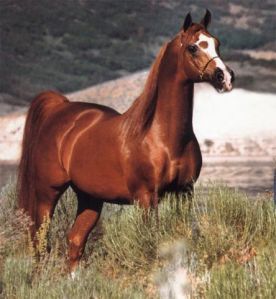
Muscat
Padron was considered as being “Russian”, but he was only half that. It has been precisely calculated that his pedigree consists of 50% English, 25% Egyptian, 12,5% Polish and 12,5% French blood.
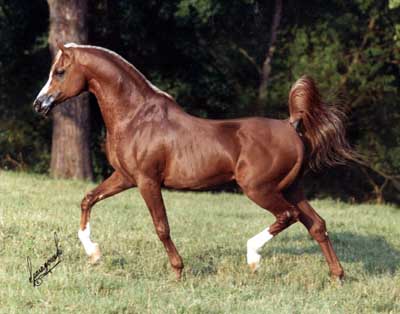 Padron
Padron
His dam Odessa was born in Belgium. Her sire was Bright Wings – UK Reserve Champion Colt from 1966 and her dam – Serinda, UK Champion in the foals’ category from 1969. Odessa was of pure Crabbet origin, from the line of Rodania d.b., which Padron was a typical representative of (a chestnut with white markings – a blaze and socks).

Odessa

Bright Wings
At the age of three (already in the US) he was getting ready by David Boggs to conquer the show arenas. In David’s hands Padron won all that could’ve been won in North America, achieving the title of Champion in Canada (1981), in Scottsdale (1982), in the US Nationals (also 1982), Reserve Champion in Scottsdale in 1979 and 1981, as well as Cow Palace Show Champion, Region III Champion and Minnesota All Arabian Supreme Champion. After changing owners, he found his way to Lasma. However, he did not fit into their Polish-orientated breeding program. He was used only once, and the foaled colt was gelded. In that same year Padron wrote himself down as the object of the most expensive syndicate in the history of Arabian horse breeding – for the amount of 11 million dollars! The main owners were David Boggs and John O’Brien, who later imported Padron’s dam, Odessa, to the US.
Padron’s most significant offspring is Padrons Psyche – foaled on the 28th of May 1988 at the McPherson Family Trust. His dam Kilika was the daughter of the Tersk-bred Tamerlan (son of the Polish Arax) and the mare Kilifa. The most famous sons of Padrons Psyche were Enzo (Padrons Psyche × RD Bey Shahmpane) as well as Magnum Psyche (Padrons Psyche x A Fancy Miracle)
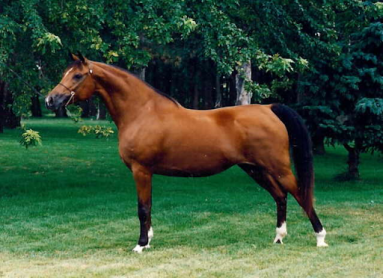
Kilika

Tamerlan

Kilifa

Padrons Psyche

Enzo

Magnum Psyche
Half brother from Enzo and Magnum Psyche was Standout DD (Padron Psyche + RSD STNDG Ovation) sire of Samah

Standout DD
Domestic Bloodline: (USA)
In 1725, Nathan Harrison from Virginia imported the first Arabian stallion into the colonies. The next Arabian enthusiast in the United States and the first Arabian breeder was A. Keene Richard who imported between 1853 and 1856 several stallions and mares for breeding, but the Civil War interrupted his breeding program, and no horses survived.
In 1877, General Ulysses S. Grant visited Abdul Hamid II, His Imperial Majesty the Sultan of Turkey. There, he was presented with two stallions from The Sultan stable, Leopard and Lindentree. Leopard was later given to Randolph Huntington who subsequently imported two mares and two stallions in 1888 from England. This program, limited as it was, must be considered the first purebred Arabian breeding program in the U.S.

The popularization of Arabian horses in the United States began with the introduction of 45 Arabian horses from Turkey at the Chicago World’s Fair in 1893 that were eventually dispersed to breeders throughout the United States. Among the imported Arabians shown were the mare Nejdme and the stallion, Obeyran. Both subsequently became foundation animals No. 1 and No. 2 in the Arabian Stud Book of America (later changed to the Arabian Horse Registry of America and now, Arabian Horse Association).
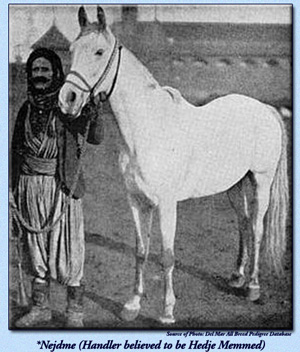

One of the most significant importations occurred in 1906 when Homer Davenport received permission from the Sultan of Turkey to export Arabian horses. Davenport, with the backing of then President Theodore Roosevelt, imported 27 horses that became the foundation of “Davenport Arabians.”
Homer Davenport brought to the U.S.A. six pure-in-the-strain-bred Arabian horses (Kusof-Reshan-Abeyah-Urfah-Jedah) and three in related type and strain (Houran-Wadduda-Moharra). Eleven other Arabs were of related classic strains and three whose sires are not mentioned in our studbooks (and cannot classify therefore). Only four of the twenty-seven horses were of mixed strains. This record alone should prove that the majority of horse breeders among the Bedouins in 1906 were still breeding pure-in-the-strain or within the classic strains.
The Davenport importation of Arabian horses direct from the desert excited the few Arabian breeders in this country and was named “The Second Foundation”.
The second foundation mares were Dhalana, Dharanah, Dharebah, Dhanad, Saranah, Tara, Asara, Ehwat-Ansarlah, Antan, and Maedae. Second foundation stallions were Tripoli, El Alamein, Dharantez, Nahas, Kamil Ibn Salan, and Ralf.
Between 1898 and 1911, Spencer Borden imported twenty horses to his Interlachen Stud; W.R. Brown imported twenty horses from England, six from France, and seven from Egypt between 1918 and 1932.
This group of breeders decided that the time was right to form a registry to promote the horse and encourage the importation of new blood. In 1908, the Arabian Horse Club of America was formed (today known as the Arabian Horse Association) and the first studbook published.
Recognition of the Arabian studbook by the U.S. Department of Agriculture established the Registry as a national registry and the only one for the purebred Arabian breed. Seventy-one purebred Arabians were registered at that point.
MUSON, one of Davenport’s Desert Arabs, created a sensation at his appearance in Madison Square Garden in 1907 when Colonel Cody (Buffalo Bill) mounted him at the opening of his “Congress of Wild Riders and Wild West Show.” President Theodore Roosevelt and his guests paid homage to this great horse, “which fulfilled the fanciful picture that one has in mind when you mention Arabian horses.” (Muson was a Kuhaylan, sired by a Shuwayman who belongs to the same classic antique type as the Kuhaylan) A more powerful and at the same time such a graceful horse had never been seen, gentle, alert and of beautiful symmetrical proportions. One of the unforgettable impressions created by Muson was when a full-blooded Indian, seventy-two year old “Bull Bear,” High Chief of the Cheyennes mounted him and gave an exhibition of bareback riding.
The old warrior of the plains handled the high-spirited Arabian stallion without effort, sitting erect and stern in his place, a noble red man.

Another significant importation occurred in the 1920s, when the Kellogg Ranch, founded by W.K. Kellogg, brought in 17 select horses from the Crabbet stud farm in 1926 and 1927. Soon after, Roger Selby established the Selby Stud with 20 horses imported from Crabbet between 1928 and 1933.
The Albert Harris importation consisted of two horses from England in 1924 and five from the Hejaz and Nejd desert regions in 1930 and 1931.
Joseph Draper brought Spanish Arabians into the American picture when he imported five horses from Spain in 1934. J.M. Dickinson’s Traveler’s Rest Arabian Stud was established between 1934 to 1937 on an imported mare from Egypt and one from Brazil as well as seven mares from Poland. Henry B. Babson sent people to Egypt in 1932 who brought over two stallions and five mares. This farm still preserves the same blood lines today.
In the United States, the term “Domestic” refers to horses born of animals that have lived in this country for two generations whose lineage is not maintained as “straight” or “pure” in any direction.
Famous Domestic stallions include Ferzon, Fadjur, Abu Farwa, The Real McCoy and Khemosabi++++.




Khemosabi was bred by Dr. Bert and Ruth Husband, sired by the stallion Amerigo and out of the mare Jurneeka++. This pedigree was primarily a combination of blood lines from the breeding programs of W.K. Kellogg and Henry Babson. Khemosabi’s dam (female) line traced to *Wadduda, the celebrated “War Mare” imported from the desert by American political cartoonist, Homer Davenport. The closest imported horse in his pedigree was his maternal granddam, the Polish-bred mare *Szarza, As such, Khemosabi was a product of Arabian blood lines that had been developed in the United States for several generations, and therefore was promoted as an “All-American” horse.

Amerigo

Jurneeka ++

Khemosabi ++++
Khemosabi was foaled in Husband’s back yard in Whittier, California. Khemosabi stood at stud in 1969, his first breeding season, on lease to Varian Arabians. After his national wins, he was syndicated in 1980 by the Husband’s son, Paul, with Ruth Husband serving as Syndicate Manager from the inception of the Khemosabi Syndicate for the rest of the stallion’s life. Khemosabi died in 2001 at the age of 34.
Delving into blood lines is a passion of many owners who become captivated with the romantic history of their own Arabian horses. The Arabian breed has endured through wars, political regime changes and geographical holocausts and holds the wisdom of the ages deep in its soul. To some, the horse stands as a piece of living history, honed to perfection through centuries of selective breeding.
Arabian Horse Association Codes:
* = The horse was imported into the United States
+ = Legion of Honor
+/ = Legion of Supreme Honor
+// = Legion of Excellence
++ = Legion of Merit
+++ = Legion of Supreme Merit
++++ = Legion of Masters
Australia Arabian Horse Breeding:
Arabian horses were introduced to Australia in the earliest days of European Settlement. Early imports included both purebred Arabians and light Spanish “Jennets” from Andalusia, many Arabians also came from India. Based on records describing stallions “of Arabic and Persian blood”, the first Arabian horses were probably imported to Australia in several groups between 1788 and 1802. About 1803, a merchant named Robert Campbell imported a bay Arabian stallion, Hector, from India; Hector was said to have been owned by Arthur Wellesley, who later became known as the Duke of Wellington. In 1804 two additional Arabians, also from India, arrived in Tasmania one of whom, White William, sired the first purebred Arabian foal born in Australia, a stallion named Derwent.

Hector
Some other notable stallions were Saladin [early 1800’s] and Model [1818]
Throughout the 19th century, many more Arabians came to Australia, though most were used to produce crossbred horses and left no recorded purebred descendants. The first significant imports to be permanently recorded with offspring still appearing in modern purebred Arabian pedigrees were those of James Boucaut, who in 1891 imported several Arabians from Wilfred and Lady Anne Blunt’s Crabbet Arabian Stud in England. Purebred Arabians were used to improve racehorses and some of them became quite famous as such; about 100 Arabian sires are included in the Australian Stud Book (for Thoroughbred racehorses). The military was also involved in the promotion of breeding cavalry horses, especially around World War I. They were part of the foundation of several breeds considered uniquely Australian, including the Australian Pony, the Waler and the Australian Stock Horse.
It was not until 196O that the first Volume of “The Australasian Arab Horse Stud Book” appeared, and in the meantime some very fine horses “fell between the cracks”.
It is a matter of regret that a number of quality Arabians came into this country before records of Arabian breeding were kept, and hence we have lost almost all trace of their stock. Among them were two very significant stallions from the most influential Arabian Stud in England, The Crabbet Stud – Hadban and Kars – together with the mares Francolin and Purple Stock. There were also the stallions Farhan and Alif [1875] brought in by Mr Dangar, and some mares.
In the early 20th century, more Arabian horses, mostly of Crabbet bloodlines, arrived in Australia. The first Arabians of Polish breeding arrived in 1966, and Egyptian lines were first imported in 1970. Arabian horses from the rest of the world followed, and today the Australian Arabian horse registry is the second largest in the world, next to that of the United States.
Arabian Horse Legends
Although Arabian horse history starts many thousandth years ago, there are some recent stallions an mares that have built history or become legends.
We will talk briefly about some of them that have been chosen as the most important ones.
Twenty four horses have been chosen in this list:
- *Bask ++
- *Witez II
- Xenophonn
- *Aladdinn
- Samtyr
- *Naborr
- *Muscat
- *Padron
- *Ansata Ibn Halima
- *Morafic
- *Sakr
- *Sanacht
- *Raffles
- Indraff
- *Raseyn
- Abu Farwa
- *Serafix
- Skorage
- Bay-Abi
- Bay El Bey
- Bint Sahara
- Ferzon
- Fadjur
- Khemosabi
*Note: SAMAH includes in her Pedigree 15 of the 24 Legend Arabian Horses (all marked in red); TATURK includes in his Pedirgree 2 of them marked in blue.
*BASK (1956-1979) [ Witraz & Balalajka ]

Quite simply the most influential and recognized Arabian horse of the 20th Century.
Bred by Albigowa State Stud, Poland. *Bask began his race training in Poland at the age of two. He remained in the racing program for a full four years. Exported in 1963 to Lasma Arabians, USA. At the age of 16 he became Scottsdale Champion stallion and later on he was the first Arabian stallion to win the national championship under saddle.
Bask sired 1,050 registered Arabians, from which came 196 National winners. His first stud fee was $500 usd and by 1970 his stud fee climbed to $10,000 usd
One of his best daughters was “Star of Ofir” mother of “Bey Shah”
Bask died on July 24, 1979 from a rupture intestine at the age of 23, he was buried at Lasma Arabians an in early 1990´s his remains were transferred to the Kentucky Horse Park.
*WITEZ II (1938-1965) [ Ofir & Federacja ]

Bred at Janow Podlaski Stud in Poland, Witez is an ancient Polish name meaning “Chieftain, knight, hero, prince”. In 1939 Hitler invaded Poland (World War II) and the Janow Stud was took and dispersed the herd throughout the countryside. He was took by German soldiers and shipped him to Hostau Stud farm in Czecho-slovakia with another 600 horses. On April 28 1945 the American Army took Hostau Stud and rescue 200 horses from different breeds; move them to Monsbach Stud, then ship them to USA on 1946 to the Kellogg Ranch in Pomona, California.
Frances Hurlbutt purchased him in an auction at Fort Reno in Oklahoma.
Witez II sired 223 registered purebred Arabians and died on June 9, 1965 at the age of 27.
XENOPHONN (1972 – ) [ Bolero & Farviews Kamal ]
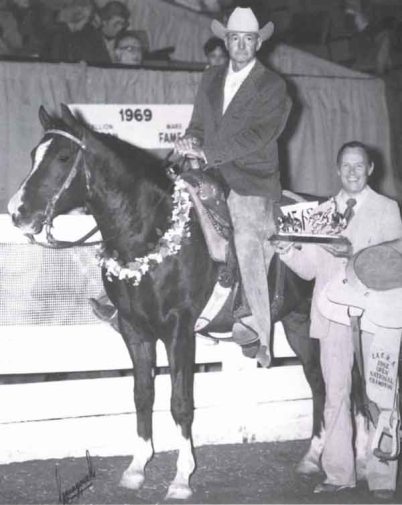
No horse has had as much direct influence on the purebred Arabians working western divisions, specially cutting, better known as “Zee”.
Zee was foaled at southern Californian Dr. Harvey A. Cohen farm and soon sold to Charlene Fletcher, later on purchased by Tom Miller.
He became 3 times U.S. National Champion in open & novice cutting an 3 times U.S. Reserve Champion in ladies open cutting.
*ALADDINN (1975 – 2010) [ Nureddin & Lalage ]

Aladdinn was foaled in February 13, 1975 on the farm of Eric Erlandsson in Sweeden. At the age of 3 he won the local National Championship he was exported to the U.S. on 1978 to Lasman Arabians to continue their breeding program after Bask.
Aladdinn foaled 1,172 purebred Arabian foals, He own the honor together with Bask & Khemosabi to have more than 1,000 registered foals. He was 1979 U.S. National Champion Stallion. Lasman Arabians was then own by a Japanese businessman Ryohei Ishikawa an Aladdinn was sold to Rick Taylor who was the owner of Muscat.
SAMTYR (1971-1995) [ Sambor & Tryncza ]

Samtyr was bred by Leon Rubin of Sir William Farm at Hillsdale, New York. He was pure Polish Arabian. He was sold to Dr. Sam Harrison at the age of 6 months for $3,500 usd and move to Tennessee. Ten times he was Arabian Racehorse Sire of the year (1980 to 1988 and 1993) and was syndicated in 1984 for $500,000 usd.
He foaled 262 pure-breed Arabians and earn in races $ 2,148,118 usd. Then was sold to Jim Wagner or Godolphin Racing Inc. in early 90´s
Died in 1995 at the age of 24.
*NABORR (1950-1977) [ Negatiw & Lagodna ]
Naborr was bred in Russia at Tersk; then was sold to Michalow State Stud of Poland to be use to rebuilt Polish bloodline after WWII. He was bought by Mrs. Anne McCormick on 1963 and ship him together with Bask in the same ship to the U.S.
On 1969 under a McCormick auction Naborr was sold to Tom Chauncey for $150,000 usd
He foaled 413 pure-breed Arabians registered.
*MUSCAT (1971-1977) [ Salon & Malpia ]

Muscat was bred in Russia and became one of the most value stallions on their breeding program. Howard F. Kale Jr. an American breeder met this horse at the Tersk facility and got crazy about him but the horse was not in sale.
Kale contacted Alexander Martinenkov Director of the horse breeding program in the Ministry of Agriculture an ask him “What does the Soviet Union Agricultural Department want more than it wants Muscat?” – Two of America´s very best Standardbred Stallions.
So he got the 2 stallions and swift them for Muscat.
He was triple Crown winner in 1980 (Scottsdale Champion Stallion, Canada National Champion & U.S. National Champion), foaled 1,028 purebred foals registered.
*PADRON (1977-2007) [ Patron & Odessa ]

Padron was bred by Dr. J.M.M Blaauwhof in a Dutch farm close to Kerkdriel in Holland.
At 3 months he was named Dutch Junior National Champion and soon he was exported to the U.S. bought by Robert Stratmore of Make-Believe Farm, Alamo, California.
He was trained by David Boggs a Halter showman and became U.S. National Champion Stallion, Scottsdale Champion Stallion & Canadian Champion Stallion.
In 1983 was purchased by Lasma Arabians and soon was syndicated for $ 11,000,000 usd.
Padron sired 817 pure-breed registered foals but the most recognized one was “Padrons Psyche” out of Kilika a daughter of Tamerlan.
Padron died in June 29, 2007 of a heart failure.
*ANSATA IBN HALIMA (1958-1981) [ Nazzer & Halima ]

Ansata Ibn Halima is often credited on inspire in America a renew interest in Arabian Horse bred from Egypt. He was imported to U.S. in 1959 together with two fillies by Donald & Judith Forbis of Ansata Arabian Stud. Bint Mambrouka & Bint Zaafarana were the fillies imported. Son of the immortal stallion “Nazeer” that only because he was not imported to U.S. that does not appear as a legend in this list.
The price set for the 3 horses where $ 15,000 usd but finally they paid $ 10,000 usd and Ibn Halima was a bonus.
He was 3 times U.S. National top ten Stallion & Legion of Merit winner. He sired 263 registered foals. Died at the age of 23.
*MORAFIC (1956-1974) [ Nazzer & Mambrouka ]
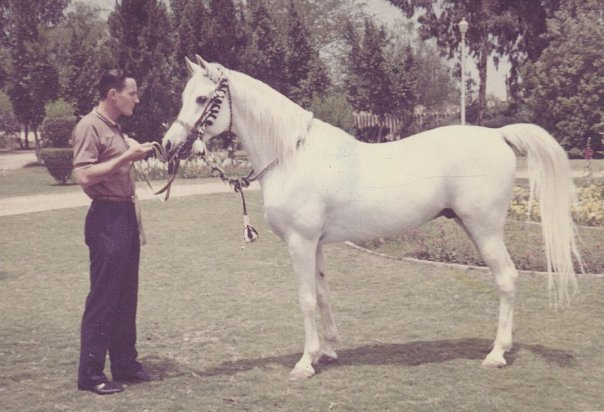
Foaled on February 19, 1956 at the RAS´s El Zahraa Stud Farm near Cairo, he became quickly known for his unique appearance and was often paraded for visitors.
As were most young Egyptian Arabian horses, Morafic was sent to racetrack. Strong and talented, but difficult to control, frightening his jockeys and trainer. After going into a fence and got a neck blemish he was returned to El Zahraa to start as a sire.
In 1961 Douglas Marshall approached the Egyptian Agricultural Organization (RAS) an asked to buy Morafic, they agreed as soon as he had sired enough horses in Egypt Marshall could buy him.
Until 1965 the white stallion left his desert homeland to move to southern Texas. Morafic sired in total 207 purebred Arabians (56 in Egypt & 151 in USA)
Morafic died on March 1974 after a colic surgery at the age of 18.
*SAKR (1968-1997) [ Sultann & Enayat ]

Foaled in Egypt on January 1st 1968 out of Morafic daughter Enayat, he was imported to the United States in November 1968 by H.J. Heubner. At 2 years old was purchase by Douglas Marshall from Gleannloch Farms (Spring, TX). He won his first halter show at the age of 2. Then he won 123 championships in halter & performance, 13 national titles.
Sakr sired 105 registered purebred Arabians, his most recognized one was Nabiel. In 1991 Mr. Marshall decide to disperse his Egyptian Arabian horses and give the horse to it´s all time trainer Mr. McNair who kept him until he died on June 3 1997.
*SANACHT (1960-1986) [ Hadban Enzahi & Haltor ]

Foaled on February 25 1960 at Marbach Stud (Wurttemburg State Stud / Germany). She was purchase for $ 750 usd by Paul Loeber from Plum Grove Farm and ship her to New York on 1962. She was one of the true equine bargains of the 20th Century.
She produced 15 foals of which 12 became champions an holds the record of “most champions from one dam”.
All 15 of “Sanacht´s offspring bear the prefix name “AMURATH”
She died at the age of 26 in 1986
*RAFFLES (1926-1953) [ Skowronek & Rifala ]

He was the result of a cross of legendary polish bred horses. His breeder, Lady Judith Wentworth of Crabbet Stud England, consider him little more than a “Pretty Pony” ideal for a son.
He was considered to be sterile and was added as a free bonus to a package of 20 horses purchased by Roger Selby in 1932.
Jimmy & Thelma Dean took care of the horse and finally could ride him after many years, then they bred him with two pony mares and confirmed he was not sterile.
Then they bred him with Indaia & Rishafieh arabian mares an got two magnificent offsprings – Indraff & Raffieh. He sired 122 registered foals from 1938 to 1953.
Indraff was sold later to Bazy Tankersley of Al-Marah Arabians as a foundation stallion.
In 1949 while feeding Raffles he broke his leg, it was supposed to be sacrifice but Jimmy & Thelma Dean took the risk to save him, the veterinarian placed a splint and built a sling to keep him for recovery. During 4 months they stay with Raffles 24 hours until he recovered. During this period Roger Selby started disbanding his Stud farm an Alice Payne from Asil Arabians wanted Raffles for years but could not get him until she finally convinced Selby.
He was move to California on November 1949 to Asil Arabians until he died on May 11 1953 at the age of 27.
INDRAFF (1938-1963) [ Raffles & Indaia ]

Indraff was the first purebred Arabian son born of Raffles, foaled on May 9, 1938.
Roger Selby sold him to Donald Shutz and later on purchased by Bazy Tankersley of Al-Marah Arabians. He sired 254 purebred Arabians.
In 1961 Indraff suffered a severe stroke which left his hindquarters paralyzed. He could use his back legs for some support and hop along as he walked with his front legs.
Because of his libido was unchanged, they use a block & tackle to lift him up to cover mares.
In 1963 he suffered another stroke but this time he constantly needed to have a canvas sling. He died on August 22, 1963 and his preserved skeleton is on display at the Arabian Horse Center in Denver.
RASEYN (1923-1952) [ Skowronek & Rayya ]

Foaled at Crabbet Park Stud in 1923, he was attractive, had good conformation and possessed an excellent pedigree. His sire Skowronek is considered by many to be the greatest recorded Arabian Sire of all time. While Raseyn´s sire had everything to recommend him, his dam Rayya unfortunately was downright ugly with poor conformation and type. Lady Wentworth included her in a package or 17 horses sold to the cereal magnate Will Keith (Kellogg) in 1926 for about $80,000.
In 1926 Carl Schmidt (who later changed his last name to Carl Raswan) Kellogg Farm manager went to England to purchase horses. On April 10 he returned with 14 horses ( Nasik, Raswan and 3 year old Raseyn).
There is no question that he was one of the most influential Crabbet-bred stallion to arrive on American shores. Not only he had fame as individual , but his breeding legacy is directly responsible for such legends as Khemosabi, Bay-Abi, Ferzon and much of Bint-Sahara dynasty. But Raseyn was the second choice at Kellogg herd breeding program after Raswan.
For 20 years, beginning in 1928 Raseyn was used as breeding stallion siring 135 registered purebred foals.
Just before Kellogg Foundation regained the ranch and its horses, in 1928 breeding seasons it was discovered that Raseyn had become sterile at the age of 25 and quite arthritic, so the Army decided to put him down. Enter Alice Payne entered a plea to spare the stallion´s life and allow him to live with her at “Asil Ranch” her old stallions home at Chino, California. The conclusion of Raseyn´s story could not be more poetic. Mrs Payne in 1950 acquire Raffles (who was his greatest rival in terms of sire lines in American champions). Of 25,569 entries in Arabian studbooks from 1950 through 1965, 6773 (one-fourth) of all foals registered were of the Raffles and Raseyn bloodlines.
Raseyn died on May 19, 1952, following a stroke at the Payne Ranch at the age of 29.
ABU FARWA (1940-1972) [ Rabiyas & Rissletta ]

“Abu Farwa” meaning Father of Chestnuts – he grew up to sire 220 chestnut offspring in his 277 registered foals.
Known best as sire of versatile horses with a “can do” attitude, he sired descendants who excel today in virtually every competitive venue: in Halter with Kontiki, in Cutting with Smooth Zee, Demaciado, Overlook Farwa and in other arena performance divisions with Oran´s Adagio, Infra Red, Ross´Zi and Fateena.
He was foaled in May 22, 1940 at the famous W.K. Kellogg Ranch, located in what is now the campus of California State Politechnic University in Pomona.
Abu Farwa dynasty is of course, the most prolific in its number of champion-siring sons. He had the beautiful neck of the Naseem line and a head with more class. As a yearling he was sold to Paul Paul a fruit grower from Fresno and won his first Halter show as young colt. When Mr. Paul dispersed his Arabian herd, Abu Farwa was sold to Herman Dreyer another farmer from the region.
Herbert H. Reese – Kellogg´s manager for many years earned a Ranch in Covina and eagerly purchase Abu Farwa in 1944 for $2,000 usd and kept the stallion for the most of his life.
Abu was first offered at public stud for $50 usd. Reese bred the horse to any mare whose owner had money to pay the stud fee. His best son by far, was Ga´Zi a brilliant chestnut with a full blaze that sired 21 National winners who won 52 U.S. and Canadian Top Ten or better awards in Halter. Reese leased Abu Farwa back to his birhtplace, now more commonly known as Cal Poly in 1952 & 1953 to be used in the breeding program and as a star attraction in the Sunday Shows.
In 1959, Reese sold Abu Farwa to Dr. Harold West of Green Acres Ranch and there he sired 10 foals. Two years later, however, when the stallion was 21, Reese bought him back in a partnership with Charles Doner of Elsinore Stud. As he got older, arthritis began to take its toll and became very painful for him to get around. Finally Mr. Doner decided to put him down and died on July 27, 1972 at the age of 32 years.
SERAFIX (1949-1973) [ Raktha & Serafina ]

Serafix became such an exceptional sire with no surprise when you consider the illustrious horses scattered throughout his pedigree. His color an white markings possibly came from the legendary and loudly marked chestnut Mesaoud (imported to England from Egypt by Lady Wentworth´s parents). Raktha (Serafix´s sire) was a grey bred by Lady Yule at the Hanstead Stud, but who was of Crabbet bloodlines. Lady Wentworth purchased Raktha at the age of 5 and was used in her program until his sale to South Africa at the age of 16.
Serafix won the yearling colt price at the London Horse Show and immediately spotted by John Rogers a mining engineer that attended to the show an he immediately asked Cecil Covey (manager of Lady Judith Wentworth´s Crabbet Park Arabian Stud) about his pedigree and price, but at that moment it was to high for his aspirations.
Until 1954 on a trip to England Rogers could close the deal on Serafix for what at that time was the largest price paid for any stallion brought to America. The horse was flew to California with two other horses owned by Cowboy Roy Rogers and finally arrived to Walnut Creek. Just after his arrival to the facility the horse stopped eating!
He was stabled with “Natez” and they immediately took dislike to each other and Serafix went off his feed.
Natez was moved to a different barn, but Serafix continued to be uneasy and nervous, and only picked a small feed. After talking with Lady Wentworth the conclusion was that he missed his groom, who has always fed & handle him, and he was lonesome for human companionship. Rogers soon developed a routine returning from work at 7 pm, and talk to him, scratch him, pet him and groom him thoroughly, take out the feed he´d refuse and put in identically the same feed and try to feed him by hand.
Of Serafix´s 259 registered foals, 128 were champions in halter and or performance.
Serafix died in 1973 at the age of 24.
Breed Standard
The Arabian horse’s physical attributes result from its desert heritage, making it both athletic and beautiful. It´s short, dished head and flaring nostrils allowed maximum oxygen intake.
Long eyelashes protected eyes from sun, wind and sand. A long, arched neck kept the windpipe defined and clear to carry air to the lungs. Well-sprung ribs and a deep chest cavity left plenty of room for lung expansion.
A short back provided strength under saddle over long distances. Dense bone provided strong resilient legs. Large, round hooves helped navigation on sand. A combination of harsh environment, long distance travel, combat, and scarce food and water created a breed with incredible stamina.
Considered to be one of the most intelligent breeds, the Arabian possesses a long memory, quick comprehension, curiosity, sociability and a loyal disposition.
Coat Colors
The Arabian Horse Association registers purebred horses with the coat colors Bay, Gray, Chestnut, Black, and Roan.
Bay, gray, and chestnut are the most common; black and roan are the less common.
The classic roan gene does not appear to exist in Arabians; rather, Arabians registered by breeders as “Roan” are usually expressing rabicano or, sometimes, sabino patterns with roan features.
All Arabians, no matter their coat color, have black skin, except under white markings. Black skin provide protection from the intense desert sun.

Chestnut

Black

Roan
Gray and White
Although many Arabians appear to have a “White” hair coat, they are not genetically “White”. This color is usually created by the natural action of the gray gene, and virtually all white-looking Arabians are actually grays. A specialized colorization seen in some older gray Arabians is the so-called “bloody-shoulder“, which is a particular type of “flea-bitten” gray with localized aggregations of pigment on the shoulder.

Grey

Flea-bitten

Bloody-Shoulder
There are a very few Arabians registered as “White” having a white coat, pink skin and dark eyes from birth. These animals are believed to manifest a new form of dominant white, a result of a nonsense mutation in DNA tracing to a single stallion foaled in 1996. This horse was originally thought to be a sabino, but actually was found to have a new form of dominant white mutation, now labeled W3.
A grey horse’s coat color is a mixture of white and dark hairs growing out of dark skin. Rarely is any Arabian foal born as a distinctly recognizable grey. They are usually born chestnut or bay, and within weeks will begin showing signs of grey around the eyes, flank, and below the elbow.
Occasionally, grey splotches will develop on the body, croup, or thigh before they are visible around the eyes.
During the greying process, a horse may show varying shades of grey. Some may appear steel grey, a mixture of black and white hairs.
Others may be rose grey, a mixture of chestnut and white hairs, or bay grey, a mixture of bay and white hairs.
Dappling is common. As grey horses age, their coat colors lighten, sometimes appearing to be white. Oftentimes, older grey horses grow tufts of reddish brown hair. This coloring is called “flea-bitten.” All of these combinations are registered “grey.”

Dominant White Arabian

Bay
Bay horses come in a variety of reddish-brown hues, and are distinguished by black points (mane, tail, legs, ears, knees, hocks, or any combination thereof). If there are white markings on the legs, there will usually be black above the markings.
Light bay horses may seem to resemble chestnuts in some cases, but the distinguishing difference will be the presence of black points.

Light Bay

Medium Bay

Dark Bay

Chestnut
Chestnuts are a copper color, varying in shades from a light golden-red to a dark brown, known as “liver chestnut.”
Occasionally, a chestnut will have a “flaxen,” or blonde, mane and tail. Sometimes, the mane and tail will be a mixture of blonde and chestnut hairs or brown and chestnut hairs. Quite often, the mane and tail will be the same color as the body coat.
Chestnut foals often have light blonde baby hair on their legs. This hair should not be confused with true white markings. If you aren’t sure, wet down the hair and look for pink skin.

Chestnut

Flaxen Chestnut

Liver Chestnut

Black
The entire coat, including the muzzle, flanks, and legs, must be black with the exception of white markings. If any doubt arises between black and dark bay, black can be determined by noting the fine black hair on the muzzle.

Black Arabian
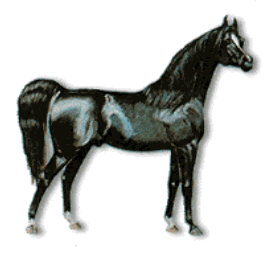
Sabino
One spotting pattern, sabino, does exist in purebred Arabians. Sabino coloring is characterized by white markings such as “high white” above the knees and hocks, irregular spotting on the legs, belly and face, white markings that extend beyond the eyes or under the chin and jaw, and sometimes lacy or roaned edges.
The genetic mechanism that produces sabino patterning in Arabians is undetermined, and more than one gene may be involved. Studies at the University of California, Davis indicate that Arabians do not appear to carry the autosomal dominant gene “SB1” or sabino 1, that often produces bold spotting and some completely white horses in other breeds. The inheritance patterns observed in sabino-like Arabians also do not follow the same mode of inheritance as sabino 1.

Pikhasso – Sabino Arabian Horse
Rabicano or Roan
There are very few Arabians registered as roan, and according to researcher D. Phillip Sponenberg, roaning in purebred Arabians is actually the action of rabicano genetics. Unlike a genetic roan, rabicano is a partial roan-like pattern; the horse does not have intermingled white and solid hairs over the entire body, only on the midsection and flanks, the head and legs are solid-colored. Some people also confuse a young gray horse with a roan because of the intermixed hair colors common to both. However, a roan does not consistently lighten with age, while a gray does.
A roan is defined for registration purposes as a horse with about a fifty-fifty mixture of white hairs with either chestnut, bay, or black hairs throughout the body. In the Arabian breed, the mixture is usually white and chestnut, creating the “strawberry roan.”
It may be difficult to tell the difference between a rose grey and a roan at first. Roans show their permanent coat color after shedding their foal coats. Unlike greys, they do not dapple nor do they progressively lighten in color. Most roans will have a dark head, while grey foals will first turn light on the head.
Colors that do not exist in purebreds
Purebred Arabians never carry dilution genes. Therefore, purebreds cannot be colors such as dun, cremello, palomino or buckskin. However, there is pictorial evidence from pottery and tombs in Ancient Egypt suggesting that spotting patterns may have existed on ancestral Arabian-type horses in antiquity. Nonetheless, purebred Arabians today do not carry genes for pinto or Leopard complex (“Appaloosa”) spotting patterns, except for sabino.
A tobiano patterned National Show Horse, a type of Partbred Arabian or Halfbred Arabian.
Spotting or excess white was believed by many breeders to be a mark of impurity until DNA testing for verification of parentage became standard. For a time, horses with belly spots and other white markings deemed excessive were discouraged from registration and excess white was sometimes penalized in the show ring.
To produce horses with some Arabian characteristics but coat colors not found in purebreds, they have to be crossbred with other breeds. Though the purebred Arabian produces a limited range of potential colors, they do not appear to carry any color-based lethal disorders such as the frame overo gene (“O”) that can produce lethal white syndrome (LWS). Because purebred Arabians cannot produce LWS foals, Arabian mares were used as a non-affected population in some of the studies seeking the gene that caused the condition in other breeds. Nonetheless, partbred Arabian offspring can, in some cases, carry these genes if the non-Arabian parent was a carrier
The Foal Coat: Clues for Getting the Right Color:
AHA records the following coat colors: Bay, Chestnut, Grey, Black, and Roan.
Most Arabians are registered as foals between the ages of three and six months. Sometimes, this makes it difficult to correctly specify coat color on the registration application because foals are usually born chestnut or dull bay and change colors after losing their foal coats.
There are clues, however, to help owners determine what color a foal will be.
Here are a few helpful hints:
Most foals will begin to lose their fuzzy baby hair around the eyes and nostrils and the root of the tail first, followed by the legs. Check the color of the smooth hair in these areas. Usually, that will be the foal’s permanent color.
If white hairs appear on any area of the face, the foal will usually be Grey. Some horse owners say that if there are white or grey hairs on the foal’s eyelids, and if that foal has at least one grey parent, the foal will be “Grey”.
If the foal coat is replaced by black hair on the legs, the foal will usually be “Bay”.
If the foal coat on the legs is replaced by chestnut hair, and the foal’s mane and tail are not black, the foal will usually be “Chestnut”.
The rules of genetics followed by the AHA (Arabian Horse Association) are:
- Mating of two chestnuts always results in a “Chestnut foal”.
- A foal will never turn grey unless one parent is “Grey”.
- Commonly, a horse that will be black is born a “Mousy Grey” color and a foal that is born looking black will not stay that color.
Conformation
Structurally, the Arabian horse is a functional as it is attractive. The short, dished head and flaring nostrils allow for maximum oxygen intake. The large trachea allows for more lung capacity. The shield-like bulge between the eyes, the Jibbah, is said to allow for greater brain capacity. An arched neck keeps the windpipe defined and clear to carry air to the lungs. A shorter, stronger back allows Arabians to carry substantial weight in comfort. The Arabian has plenty of room for lung expansion because of well-sprung ribs and a deep chest cavity. His strong, resilient legs with dense, compact bone are free of most lameness problems, and his lighter muscling readily dissipates heat and lactic acid.
Arabian horses were bred to perform under harsh desert conditions and keep going beyond the point of exhaustion. This has given the breed incredible stamina and courage.The Arabian horse is also recognized as being intelligent and easy to train. Centuries of close interaction with people has given the Arabian an innate ability to bond with humans, as well as a friendly, loyal disposition, marked by a desire to please. Arabians possess a long memory, quick comprehension, alert curiosity, resourcefulness, and sociability. They consistently outlive other breeds reaching their prime at 20, with many living well past 30.
Head Conformation


“Jibha or Jibbah”: is a bulge in the profile of the head. Ideally, this protrusion is above the eyes. The Jibbah may result in slightly larger sinus capacity.
“Afnas”: is the “dished face” for which the Arabian horse is known. The dish is a depresion of the front bone of the head, between the eyes and the nostrils; it appears as a concave curve in the profile of the head.
“Mitbah”: Arabic term for the throat latch or attachment of head and neck. The word means ‘the place where the throat is cut’ since it is the same for camels, sheep, and goats, and they are the ones for whom it is taken literally. A fine and long mitbah is much desired in an Arabian horse.


Body Conformation
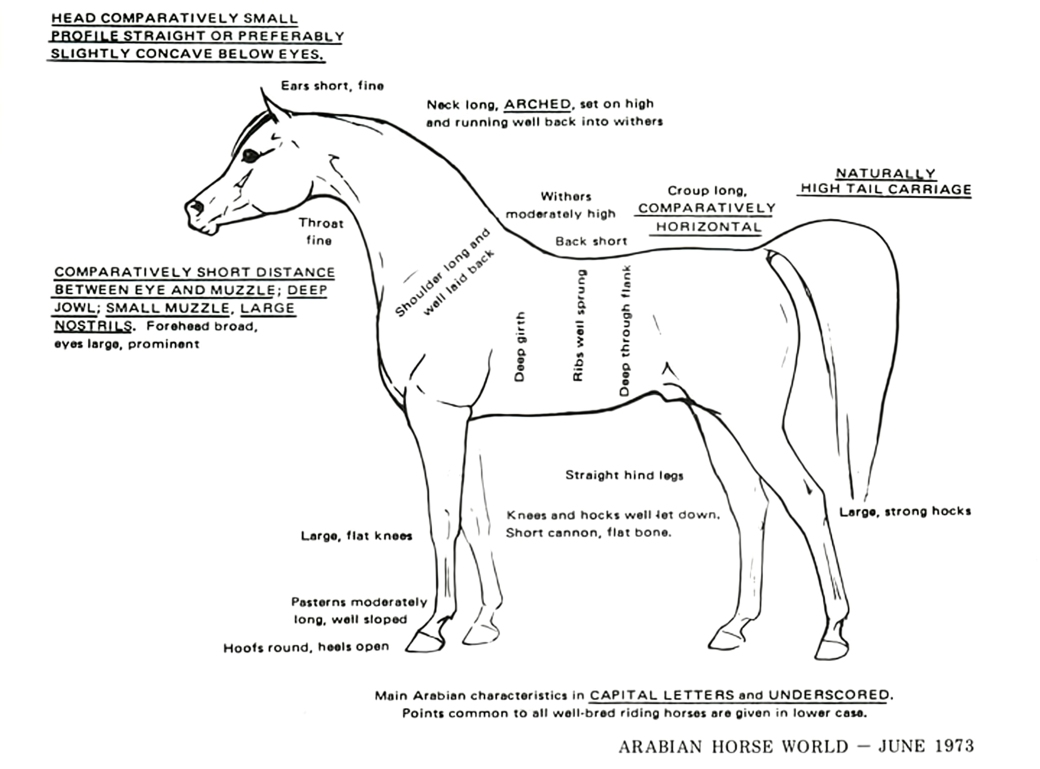

“The Arabian is known as the most beautiful of horses, and has been celebrated as such in centuries of literature and art”
Who love and appreciate the Arabian horse have an unspoken bond, not only with important historical figures of the past, but also with those breeders, owners, and enthusiasts around the world who share their passion.
Arabian horse owners will tell you that “Arabian Horse” has changed their lives. It has enabled them to travel places they might not otherwise have gone, to meet passionate people from different countries and cultures, and to take pride in “Preserving the heritage of an animal that is a true treasure of the ages”.





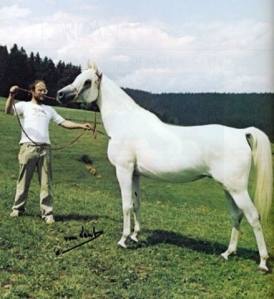


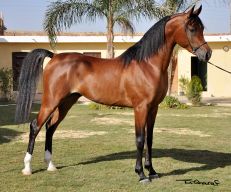

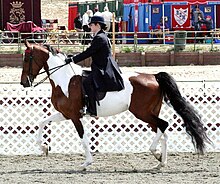
What an amazing overview of the Arabian horse! Little known facts & information is of great interest. Glad to come upon this site!
LikeLiked by 1 person
Thanks Jim! I am happy you like the information. Has take a lot of time to compile it and try to put together in order. Welcome every time you like to consult.
LikeLike
gerçekten mükemmel. çok düzgün ve gerekli biligiler. TEBRİK EDERİM TÜRKİYEDEN SELAM C*
LikeLike
Thank you! I do not speak Turkish but translated and I am happy you found the information on my page interesting!
I appreciate your comments!
LikeLike
very valuable information thanks
I have a question, what should I pay attention to when buying a thoroughbred racing Arabian horse?
thanks
LikeLiked by 1 person
Thanks Cem for your comments
I am glad you find value on the information I have been recollecting and investigating for many years
Regarding your question about purebreed racing arabian horses I am not very familiar with the specific characteristics you should look for
I understand there are specific lines of breeding that has been develop for racing besides that arabian horses are very fast
As well there are some breeding lines developed for halter show or other specialties like Endurance
I will suggest to track racing arabian horses lines that you know have been champions or good racing contenders and then try to find some conformation characteristics or breeding lines (sires, dams)
I understand in England and USA as well as other Orient countries arabian racing is very popular so on those countries there should be some horse lines that have been developed mostly for racing besides a beautiful conformation
Let me try to look in my books in order to see if I can find something special on conformation or breeding lines that could help you!
If I find something I will share it with you
I hope this small information at least will give you some idea of sources to consult
Maybe you can start searching in google for racing champions, then try to identify their pedigree an see if the have common ancestors and try to figure what are the common conformation genotypes on their conformation.
I will be back with you if I find some other information
Regards
Alejandro
LikeLike
Gracias por esta información tan útil para los que amamos los caballos…
no deja de ser romántica y admirable la presencia de la sangre árabe en casi todas las razas de caballos ….en mi país VENEZUELA ésta presente en las características de nuestro “caballo criollo’…. resistente y fiel …en sus lomos nuestros llaneros derrotaron al formidable ejército enviado por el rey de España.
LikeLike
Gracias por tus comentarios Jorge
Espero que la información de la página sea de tu interés y gusto
Estoy a tus órdenes!
LikeLike
Pingback: Arabian Horse History – The Grapevine
This is an awesome collection of information – thank you.
However, the profile of the top 24 horses appears to have a lot of grammatical errors which discounts the truth about these horses.
LikeLike
Thanks you for your kindly comments regarding the information I have been trying to put together.
Would you be so kind to be more specific about your comment regarding “Grammatical errors which discounts the truth about these horses”
I am not an English native spoken so I am quite sure that I probably type many mistakes.
I will review the info again but if you can help me with some notes it will be great.
Sincerely
Alejandro
LikeLike
Hi Alejandro,
Give me a couple of days and I will fix the errors and send to you.
Rowena.
LikeLike
<!– /* Font Definitions / @font-face {font-family:Helvetica; panose-1:2 11 5 4 2 2 2 2 2 4;} @font-face {font-family:”Cambria Math”; panose-1:2 4 5 3 5 4 6 3 2 4;} @font-face {font-family:Calibri; panose-1:2 15 5 2 2 2 4 3 2 4;} / Style Definitions */ p.MsoNormal, li.MsoNormal, div.MsoNormal {margin:0cm; font-size:11.0pt; font-family:”Calibri”,sans-serif;} h1 {mso-style-priority:9; mso-style-link:”T\00EDtulo 1 Car”; mso-margin-top-alt:auto; margin-right:0cm; mso-margin-bottom-alt:auto; margin-left:0cm; font-size:24.0pt; font-family:”Calibri”,sans-serif; font-weight:bold;} a:link, span.MsoHyperlink {mso-style-priority:99; color:blue; text-decoration:underline;} span.Ttulo1Car {mso-style-name:”T\00EDtulo 1 Car”; mso-style-priority:9; mso-style-link:”T\00EDtulo 1″; font-family:”Calibri”,sans-serif; font-weight:bold;} span.header-title {mso-style-name:header-title;} p.meta, li.meta, div.meta {mso-style-name:meta; mso-margin-top-alt:auto; margin-right:0cm; mso-margin-bottom-alt:auto; margin-left:0cm; font-size:11.0pt; font-family:”Calibri”,sans-serif;} p.comment-parent-author, li.comment-parent-author, div.comment-parent-author {mso-style-name:comment-parent-author; mso-margin-top-alt:auto; margin-right:0cm; mso-margin-bottom-alt:auto; margin-left:0cm; font-size:11.0pt; font-family:”Calibri”,sans-serif;} p.title, li.title, div.title {mso-style-name:title; mso-margin-top-alt:auto; margin-right:0cm; mso-margin-bottom-alt:auto; margin-left:0cm; font-size:11.0pt; font-family:”Calibri”,sans-serif;} .MsoChpDefault {mso-style-type:export-only;} @page WordSection1 {size:612.0pt 792.0pt; margin:72.0pt 72.0pt 72.0pt 72.0pt;} div.WordSection1 {page:WordSection1;}
LikeLike
Very nice story. I have some questions regarding color. I am trying to figure out what color the parents are if the foal is born black turned flea bitten gray by age 2 years old with black legs and silverly mane and tail still present as the parents are unknown as this time, but I am still searching. I am guessing the foal’s parents are black and other are gray. What about if one parents are black and one parents are chestnut going gray and could that the reason why the foal was born black going flea bitten gray because one parent was chestnut turned gray which is why the foal has a chestnut flea-bitten spots when she got older at 2 years old? Am I correct on this? I would appreciate if someone could answer this question for me.
LikeLike
Hello Kris
First thanks for your kindly comments!
I am very happy you found interesting the data regarding Arabian Horse History!
About your question I am not really an expert on genetics
What I have learn and investigate is that normally a foal that that has to grey parents will normally be grey and there are a lot of different let say coats under grey color, they can be dample grey, flea bitten, mostly white with some dark spots, the can have dark o black legs, tail and mane, so either both or one of her parents was grey. Black horses could be directly from homocigotus black or some times they not necessary came from black parents both it´s very rare.
Being a flea bitten grey not necessary seems one of their parents was chestnut.
For example my gelding horse now it turned to flea bitten both both parents where grey.
So your question for me it´s difficult to answer exactly, there might be some people expert on genetics that will have more scientific answer.
As far as I now there are some guidelines but not necessary are strict rules.
Hope this brief comments will at least resolve in some way your doubts.
It will be a pleasure to hear from you again!
Regards
Alejandro
LikeLike